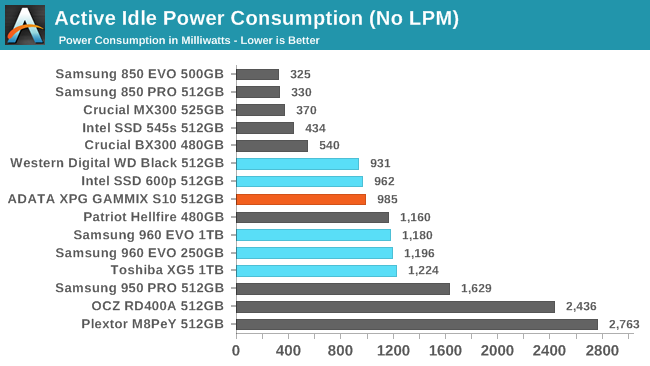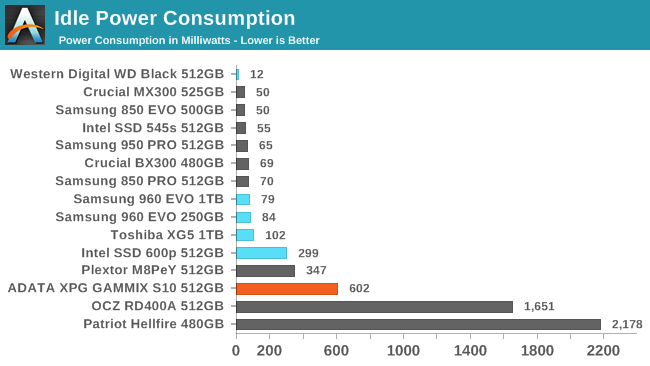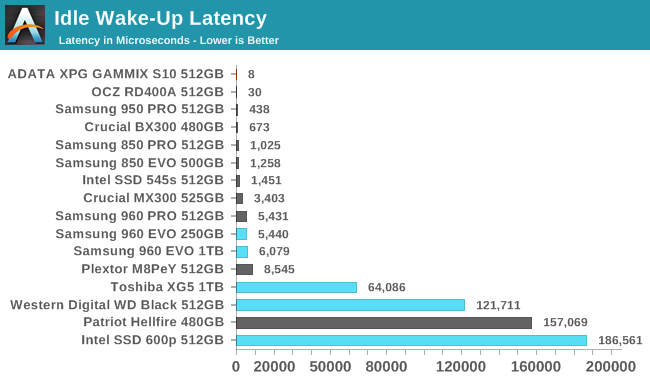The ADATA XPG GAMMIX S10 (512GB) SSD Review: Entry-Level NVMe With Style
by Billy Tallis on October 25, 2017 8:30 AM ESTPower Management
Real-world client storage workloads leave SSDs idle most of the time, so the active power measurements presented earlier in this review only account for a small part of what determines a drive's suitability for battery-powered use. Especially under light use, the power efficiency of a SSD is determined mostly be how well it can save power when idle.
SATA SSDs are tested with SATA link power management disabled to measure their active idle power draw, and with it enabled for the deeper idle power consumption score and the idle wake-up latency test. Our testbed, like any ordinary desktop system, cannot trigger the deepest DevSleep idle state.
Idle power management for NVMe SSDs is far more complicated than for SATA SSDs. NVMe SSDs can support several different idle power states, and through the Autonomous Power State Transition (APST) feature the operating system can set a drive's policy for when to drop down to a lower power state. There is typically a tradeoff in that lower-power states take longer to enter and wake up from, so the choice about what power states to use may differ for desktop and notebooks.
We report two idle power measurements. Active idle is representative of a typical desktop, where none of the advanced PCIe link or NVMe power saving features are enabled and the drive is immediately ready to process new commands. The idle power consumption metric is measured with PCIe Active State Power Management L1.2 state enabled and NVMe APST enabled.


The power management of the ADATA XPG GAMMIX S10 is a step backward from the Intel 600p. The two have similar active idle power consumption, but when enabling deeper sleep states the GAMMIX S10 ends up drawing twice as much power as the Intel 600p and an order of magnitude more than good SATA SSDs.

The poor idle power management of the GAMMIX S10 is offset by a near-instant wake-up time. The Intel 600p is one of several NVMe SSDs with a remarkably long wake-up time from their sleep states, while the GAMMIX S10's shallower suspend state clearly allows for a quick return to normal operation.










27 Comments
View All Comments
futrtrubl - Wednesday, October 25, 2017 - link
Disappointing.jabber - Wednesday, October 25, 2017 - link
Why? You wouldn't notice if it could do 3500MBps either.futrtrubl - Thursday, October 26, 2017 - link
Because it does less but costs more. What isn't disappointing about that?jabber - Thursday, October 26, 2017 - link
Yeah but it looks much fancier so to the average Joe that's worth another $30! It's a strategy that Apple has used and been praised for for decades. Performance means nothing to the computing masses. It's just those of us on IT forums that care.FullmetalTitan - Thursday, October 26, 2017 - link
No "average Joe" is even looking at NVMe SSDs.This costs double the price of a GOOD SATA SSD, and frequently fails to even meet that performance level.
jabber - Thursday, October 26, 2017 - link
You'd be amazed at what I see 'Average Joe's buy. Shocking at times."Why did you buy...that?"
ddriver - Wednesday, October 25, 2017 - link
That's some pristine engineering idiocy right there, having the heatsink make contact with only a small part of the chip area deliberately.ddriver - Wednesday, October 25, 2017 - link
"GAMMIX" - more like "gimmix" LOLrrinker - Wednesday, October 25, 2017 - link
I saw that skipped right to the conclusion for the (predicted) disappointing results. If they screw up the engineering for the sake of appearance like that, I was sure the rest of it would be disappointing as well.ddriver - Wednesday, October 25, 2017 - link
The thing is that the heatsink is protruding between the adhesive pads, so it presumably makes contact with the chip, however without any thermal interface material it is likely that the heatsink severs to insulate and worsen thermal performance than to improve it.Probably it is a mix of both, yielding somewhere between barely improving to barely "detrimenting" thermal performance, making it mostly a pointless gimmick.
Like everyone else, ADATA is well aware how low average consumer IQ is, thus attempting to make this fly.
On the bright side of things, adding some thermal paste would easily make the cooling solution functional. Although I doubt the product performance will get any less pathetic because of that. They didn't put that heatsink there because it is throttling as a side-effect of being very fast. They put it as a cosmetic feature, that much is evident from the clumsy implementation.